“I had it all,” Gary was quick to admit. “Gray flannel suit, tie, neat handkerchief in the pocket.”
Why did Gary give up his well-paid job in aerospace? Why did he exchange his fancy clothes, house, furniture, and parties for the barely-make-ends-meet salary of a graduate student?
Gary was not among those students nominated as the “person most likely to succeed” in high school. According to him he would have been voted “most unlikely to succeed.” He was advised to avoid college. But Gary liked a challenge. His attitudes changed. He completed college and won a job that amazed his former classmates.
But this was not the ending point for Gary. Inside all day in a physiology lab or behind a typewriter writing up his research, he remembered the science field methods course he had taken from Dick. Gary had taken it just for fun, not as part of his program of work. But it had been the course he had most enjoyed in college. Gradually he realized he liked working in the outdoors.
Gary’s bubbly enthusiasm, eagerness, drive, and energetic ability to play or work equally hard were now channeled toward a new goal – outdoor research and a doctoral degree.
So he moved his family to Dartmouth in Hanover, New Hampshire, and began five years of preparation to be either a college professor who did field research or a year-round researcher.
Once his goals were set, work became his play. The hairy and furry warm-blooded mammals didn’t have a chance to keep their activities and whereabouts a secret any longer. Gary, the supersleuth, was on the scene to spy on them.
Like most self-confident, eager-beaver students, Gary’s first research goals were too large. He had to limit his study. Instead of getting quantitative data on most of the mammals, Gary was guided to select a few.
First, he sampled the area to see what was present. From thirty or forty acres, he chose fourteen acres for removal grids and trapping. From his findings, he decided to study the northern jumping mouse, the deer mouse, and the Boreal red-backed vole.

He wanted to learn the number of each species in the ecosystem. And he wanted to learn what part of the standing crop of nutrients in the forest rested in these three species. He worked out annual energy budgets for each species. He wanted to know how much energy flowed through the mouse populations. He also hoped to learn whether their seed-eating habits affected the trees.
Dr. Likens’ lab chemists analyzed Gary’s mammal specimens for the same elements as the other organisms and water sampled from the forest: N, Ca, P, K, Na, Mg, Fe, Zn, Mn, and Cu. Lead, copper, and cadmium, heavy elements, were added to Gary’s analysis list. These elements might concentrate in small mammals.
He listed other mammals as he accidentally discovered them. In this way a species list grew.
To make his census he set out live traps on a grid with one hundred stations twenty-five meters apart. He marked the animals in a variety of patterns to identify captured individuals and to be able to recognize them when they were recaptured.
To check the accuracy of his live-trap census, Gary planned to snap-trap and compare the numbers.
With either trapping method, weather was a dictator. Rain told Gary to hurry out to his live traps. He freed trapped animals so they wouldn’t suffer from exposure. He released the traps so no animal would get caught. Rain tripped snap traps. Trapped raindrops did not add up to representative sampling.
Gary used a Sherman collapsible live trap which was made from shiny sheet aluminum. It was 2 ½ X 3 X 8 ½ inches large. He set the door open and baited the back room. A mouse running in stepped on the treadle and the door snapped closed. To retrieve the animal Gary opened the other end of the trap.
At his grid stations traps were set for three rainless nights. The mice were caught and marked. Other trespassers were released and described in Gary’s journal. The next eight to twelve days the traps weren’t set. Then for three more days the traps were set. The cycle was repeated several more times.
A museum special spring trap snapped out an area. It looked like a large version of a house mousetrap. The larger size saved skulls from being crushed. The museum special took larger mice too. Any properly prepared mammal specimen must be accompanied by a cleaned skull for proper species identification.
Gary prebaited for three days without setting the traps. Then he baited and set the traps for five days. The number of individuals trapped went down each night. When the individuals trapped reached a low point, he knew most of the area was trapped out. Then he knew approximately the number present. At the end of the live-trap censusing, Gary snap-trapped the two and a half acres in the middle of the live-trap census area. Then he compared results, checking his live-trap numbers with his snap-trap numbers.
Getting a mammal count was a tough job. Numbers changed a lot from place to place, hour to hour, and season to season. Since very different sets of numbers came from the same plot, many numbers were needed before a real idea of a population’s parameters – the most and least number of mice that might be present – could be obtained. Few samples would give the wrong idea. So a lot of trapping was necessary in one place.
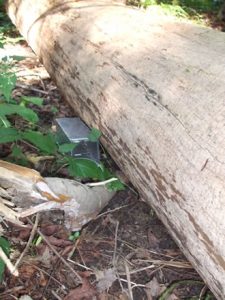
Gary found the population estimate from the recapture technique very close to his snap-trap removal numbers. His censusing data were, then, fairly close to the actual number of mice in the forest.
Even though he was getting the numbers he needed, Gary was puzzled by the distribution of the small mammals. In one habitat that looked the same as the others, he found mammals in some parts, but not in others. The mice were not evenly distributed. Gary did not know why. That might be a puzzle for another researcher to work out someday.
Some of the live-trapped mammals went to the Dartmouth lab where the amount of oxygen they used was measured. The oxygen consumption showed their metabolism rate, or how much energy the animal used just to stay alive, at different temperatures.
Gary multiplied his total number of animals by the average energy used by the individuals. This told him the minimum amount of energy used by his mouse population.
On a dining table in the farmhouse, Gary opened his tackle box of skinning equipment. Mammals were preserved in the same way as birds – skinned and stuffed.
Gary experimented to perfect his skin study technique. Scissor tips cut through the lower abdomen and up the chest to open a pocket of skin and fur. Thumbs and fingers gently pulled the pelt away from the body sack tissue that held all the inner organs. Gary turned the mouse’s coat inside out as it slipped away from the body. Snips around the ankles, eyes, ears, nose, and mouth allowed the skin coat to slide off the mouse. While the fur coat was turned inside out, Gary rubbed it in a mixture of borax and arsenic (cornmeal can also be used) to absorb body moisture. Around a loop of heavy wire, Gary wound cotton batting and pressed it into a shape that matched the removed body. Wires were pushed inside each foot, making it straight for drying. Gary became adept with a needle and thread. He neatly sewed together the chest opening. He pushed, pressed, squeezed. Soon a study skin was ready for a museum tray.
Behind the mounted animals displayed in a public museum are the museum’s working collection of study skins. Museum trays are stacked and pulled out like drawers. A series of the same species is grouped together so variations can be compared. Many colleges have their own collections of study skins. Gary could take his skins to a museum for comparison. Maybe he had an unusual species for the area. His study skin could be compared to an identified specimen and become proof of a capture.
Museums trade specimens. Each wants as complete a series of each animal as possible. To help keep the specimens from being destroyed by insects and other vermin, paradichlorobenzene is placed in the trays. The skins are protected in the same way that moth crystals protect your woolen clothing.
Like all the other researchers, Gary kept a journal of daily field happenings and discoveries. He flipped the pages of his notebook and spotted chipmunk, deer, bear, weasels, fisher, fox (red male plus blond female and two kits), and 1 male porcupine – road kill. The date, time, location, weather and other special environmental conditions were next to each entry. Many of the notations brought to mind experiences that made good stories and would not be quickly forgotten.
Busily engrossed in his trapline, Gary once baited the trigger of a trap with a peanut butter and oats mixture. Gently he placed the trap among the leaves on the ground. He was too busy keeping his finger from being snapped to be aware of anything around him. Besides, it was cloudy and very dark. A misty cloud closed in, putting him in a fog. Startled by a limb breaking near him, he looked up. He was dead center in the path of a nearsighted bear! The bear lumbered down the hill straight toward Gary. Gary waved his arms, yelled and shouted. With the bear’s momentum, he might not have been able to veer off even if Gary had scared him. Anyway, Gary didn’t pose much of a threat. At the last moment he jumped to avoid a head-to-chest collision and landed sitting in a stream. Unaware, the bear lumbered down the hillside at the same brash pace. A short ten feet had separated them.
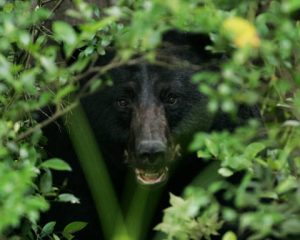
One rainy night while Gary and Tom rooted in the salamander transect plots, an unknown assailant landed, thump, on Tom’s chest and held on tightly. Light from his flashlight flickered in all directions through the forest trees as Tom tried to pull off his unseen assailant. Trying to get rid of his attacker, he ran through the forest. Gary ran after Tom, finally spotting the assailant with his flashlight. A flying squirrel had landed square on Tom’s chest. It must have been a shock for the squirrel too. How many trees could have run away with it in the past? Once in the spotlight, the squirrel sailed off and Tom’s heartbeat returned slowly to normal.
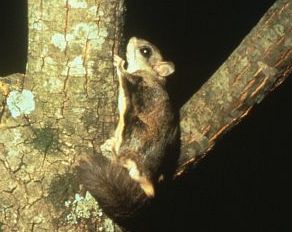
Gary and Dot checked his live-trap line one morning. Gary took two tiny, long-snouted mouselike miniatures out of his trap. The shrews had black, soft velvet fur. Their fur had no nap. It lay down flat against their bodies either way Dot smoothed it. Napless animals like the mole and shrew can run into a hole and back out without having their fur stand up and block their exit. They are two-way animals in a hole. Their fur helps them escape their predators.
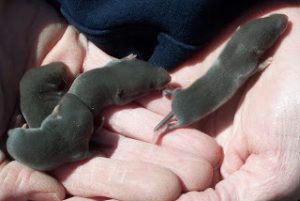
Shrews move quickly. Their small bodies lose heat rapidly. They use lots of calories and have to eat constantly to stay alive. Gary released them to continue their busy search for insects. They hadn’t known Gary was trapping only mice.
Gary had just finished his shrew notes when he heard a death-defying scream. Dot was in trouble! Running to the next trap, he found her irrationally yelling, “Help, help!” Gary thought she’d gone “over the brink.” He had never seen anyone so close to hysteria.
“Get’m out, get’m out!” she yelled. “He’s clinging, here.” Dot pointed to the crotch of her trousers. “Help me. He’ll bite!”
Gary’s hand beat the empty air, helplessly. “Take’m off, take’m off,” he yelled.
The conflict between immediately helping his screaming friend and flashing mental images of jeanless Dot caused him to freeze. How would he explain the scene to a professor walking through the forest? Clawing the air, all he could say was, “Get’m off, get’m off!”
The mouse itself solved the problem by running down Dot’s other pant leg and disappearing into the forest.
Back at the farmhouse, Dot was quiet and a bit pale. She wondered how she would have explained it all to a doctor if she had needed a tetanus shot.
Gary’s notes did not tell a lot of things he remembered.
Gary could not limit himself to small mammals. On his back watching a bird one morning, he fell asleep. When he awoke, there was a neatly coiled garter snake under his head acting as his pillow!
Another day he walked into a wasp nest chest-high on a beech tree. With one wasp sting on his arm, he ran down the slope. His wicker basket pack pounded against his back. He hoped the nest hadn’t fallen into the basket with the wasps readying themselves for the “big sting” when he stopped running. Gasping for breath, Gary dropped his pack, relived to find no wasp nest.
Never to be forgotten was the eerie quiet and pitch black before a rainstorm. The lightning crackled and changed the forest to daylight for an instant, then back to a black, lightless box. Not a mouse, not a leaf stirred. Not an animal breathed or a frass fell. This strange total quiet Gary held deep in his memory.
Snow brought a clean unclutteredness to the forest and new experiences to Gary, who kept up with mammal happenings in winter as well as summer.
Snowshoes and cross-country skis took Gary wherever he wanted to go. Sometimes he went too rapidly! Once he came to an icy trough. He slipped up one side, then down and up the other, out of control. Straddling the trough, he flew down the icy slide. Trying to keep his balance, he skied on his head. Finally he collapsed in a heap. Fortunately no bones were broken. The field life of a mammalogist does not always slide smoothly.
Missing the winter show were the jumping mice and chipmunks, comfortably hibernating under the snow.
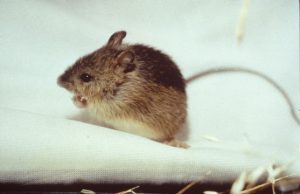
Snap traps bit Gary more than once under an early snowfall or late spring surprise snowstorm. He would grapple for the trap under the snow and, zing, a finger was trapped.
Gary tried to help the mice by giving them nest boxes ten feet off the ground. When the snow fell, he checked the boxes. But no mice, only spiders. Foiled again!
Mice, foxes, and snowshoe rabbits left neat footprints on the snow. Gary entertained himself in the winter solitude by reading the stories of recent events printed on the cold white page. Fox tracks that led from a partly eaten muskrat told him the familiar predator-prey story.
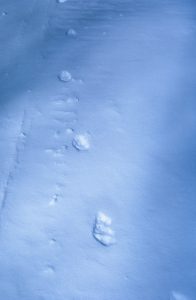
Gary, like the other graduate students, eventually counted enough animals. He was able to work out the population, the nutrient content, the biomass expressed as kilograms per hectare, and the energy consumption expressed as calories per hectare for each species he studied.
He compared his results with the ornithology and herpetology figures. He found that mammals have more biomass than birds in this forest ecosystem. But they have less than salamanders. The mammals used more energy than salamanders, but less than birds.
Gary found that the small mammals he studied were good prey, or energy source, for other organisms higher up on the food chain in the Hubbard Brook ecosystem.
The small mammal seed-eating habits did not affect the major tree species. The forest invertebrates were not affected by small mammal predation either.
Gary has reached another goal. His doctorate behind him, he seeks new goals and adventures. He will make things happen wherever he is. And the most unusual, unpredictable happenings will make new stories germinate and grow.
